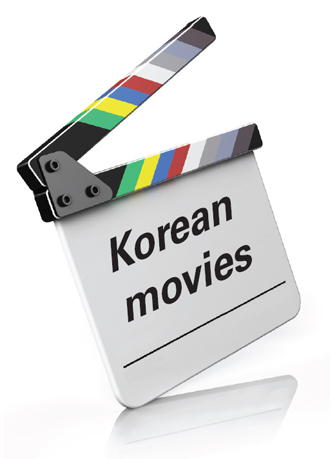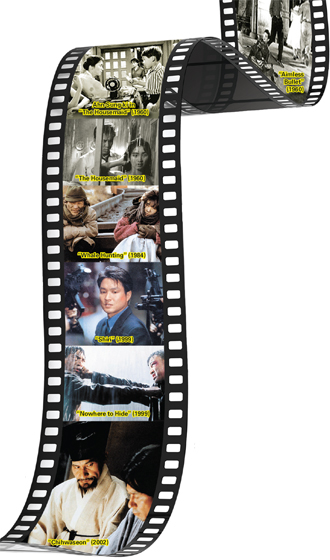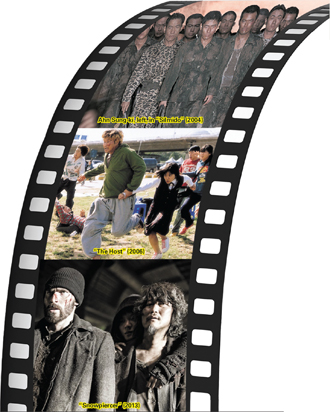After ups and downs, cinema in golden age

“It was just a couple of scenes,” Ahn said in a phone interview. “I don’t remember much. But I did a good job, so he offered me another role. I guess there were not many child actors in those days, so soon I was a regular actor.”
Like the rest of the country, South Korea’s movie industry was rebuilding after the devastation of the 1950-53 Korean War, which means Ahn’s career has been nearly as long as the Korean film business.
Today, Ahn has starred in more than 70 movies, many made by Korea’s top directors, and now is one of the country’s most visible ambassadors for cinema.
Just as Ahn’s career has seen some amazing ups and downs, so, too, has the Korean movie industry been transformed multiple times since the end of the Korean War. It recovered from the war to flourish in trying times, but declined under the military government. Then, as the economy grew and Korea opened to the West, came a time of great upheaval, followed by unprecedented success. The story of Korean cinema is, in many ways, the story of Korea.
Out of the ashes
There were many movies made before the Korean War, of course. The first films screened in the late 1890s, and by the late 1910s, movie theaters had been built here.
After 1953, the film industry struggled to get back on its feet. But from the beginning, movies were recognized as important. Movie theaters were among the first buildings rebuilt (the first two allegedly with gangster money), and the United Nations Korean Reconstruction Agency, which spent about $127 million on 260 projects to help rebuild the South, constructed studios and donated film equipment.
At first, many of those early movies were anti-Communist propaganda or about the colonial era, but the biggest hits were usually weepy melodramas. Movies may have been made quickly and on the cheap, as aspiring filmmakers basically taught themselves the basics of editing and storytelling, but even then there were signs of ambition and quality.
Even for a young Ahn, his second movie, “Defiance of a Teenager” (1959), won him a prize at the San Francisco International Film Festival. But his next film, “The Housemaid” (1960), was one of the most impactful from the era. The story of a family terrorized by their nanny (Ahn played the young son who gets murdered by the maid), “The Housemaid” was a big hit and today is one of the best-regarded movies of the era.
Directors like Shin Sang-ok, Yu Hyun-mok and Lee Man-hee helped to create a golden age of cinema. Shin’s “To the Last Day” won the Silver Bear award at the Berlin International Film Festival in 1960. And Yu’s “The Aimless Bullet” is considered a masterpiece, even though it was banned by the military government in 1961 for being too bleak in its portrayal of life in Korea.
At first, it was hard for the Korean film industry to get started in the face of stiff competition from Hollywood. In the 1950s, hundreds of Hollywood films flooded in each year, peaking with 222 in 1958. So when former President Park Chung Hee decided to get a handle on the local movie industry, a major part of his 1962 film law was about clamping down on imports. It worked, and by 1963 just 66 movies were imported, versus 144 Korean movies.
It was a fertile time, with more people going to the movies each year. That peaked in 1969, when 173 million movie tickets were sold and 229 Korean movies were made.
“Movies were my escape,” said Miky Lee, vice chairman of CJ Group, who runs the largest movie and media company in Korea, CJ E&M. “Daehan Theater was a five-minute walk from my home back then, and I remember watching ‘The Sound of Music’ 11 times.”
There were not many theaters in Seoul back then and no multiplexes. But people loved movies and would cue for hours to see the latest hits.
“In the ’70s, there were just nine first-run theaters in Seoul,” recalled longtime producer Jonathan Kim. “You had to stand in a long-ass line, and there were scalpers everywhere.”
Unfortunately, as Park’s presidency went on, he increasingly cracked down on dissent and “disruptive” influences, and the movie industry felt the bite of censorship ever more.
But the rise of television was even worse than censorship. There were just 300 TV sets in Korea in 1957, but that grew to 30,000 by 1962, then to 6.3 million by 1980. The 1970s were a golden age for TV dramas in Korea, but movie attendance dwindled, and by 1980, Koreans bought just 53.8 million movie tickets - less than a third of its peak.

From Top: “Aimless Bullet” (1960), Ahn Sung-ki in “The Housemaid” (1960), “The Housemaid” (1960), “Whale Hunting” (1984), “Shiri” (1999), “Nowhere to Hide” (1999), “Chihwaseon” (2002)
Cinema muddled along through the 1980s, suffering through what many experts have called the tightest controls of any non-Communist country in the world. Sometimes social conventions could be as constricting as any law.
“As a kid, I wasn’t even allowed to go to the movies,” said Kim. “I could only go with my parents or on school trips. If I went by myself or with friends and got caught, we could get suspended from school.”
Although under President Chun Doo-hwan, the rules on sex in movies were loosened somewhat, but mostly because the government thought a bit of skin helped keep audiences more distracted from politics.
But politics influenced Korean cinema in other ways.
As Korea enjoyed an unprecedented economic expansion, its businesses sought to expand into other markets worldwide. But Hollywood complained loudly to the U.S. government about how closed the Korean movie market was. American trade representatives threatened to impose sanctions against Korean goods if Korea did not begin to open up, and movies were a major part of those negotiations.
So the Chun administration changed the Motion Picture Law twice. In 1985, the rules on who could form film companies were loosened. Korean filmmakers liked that change, and over the next four years the number of production companies nearly quadrupled, reaching 98 in 1989.
But the 1987 changes to the film law did not go over so well. For the first time since 1962, the government allowed Hollywood to directly distribute movies in Korea.
Filmmakers flew into a rage. Without protection, they were certain their tiny industry, already tottering badly, would collapse. Filmmakers and their supporters took to the streets in protest - embarrassingly, many of those first protests came at the same time as the 1988 Seoul Olympics. Audiences trying to buy tickets to those films - “Fatal Attraction” was the first on Sept. 25, 1988 - were harassed. Snakes were even released in theaters on more than one occasion.
But by then it was too late - the law had changed and the market was open. The only thing filmmakers had to protect them was a screen quota, guaranteeing every screen in Korea would show local movies for at least 40 percent of the year - but it was a protection that was seldom enforced.
The low point came in 1993, when Korean movies accounted for 15.9 percent of all admissions - that worked out to 7.7 million ticket sales going to Korean movies for the whole year.

Frome Top: Ahn Sung-ki, left, in “Silmido” (2004), “The Host” (2006), “Snowpiercer” (2013)
Today’s CJ Group spun off from Samsung in 1993. For years, CJ’s business was mostly food processing and pharmaceuticals, but after separating, founder Lee Jay-hyun (Miky Lee’s brother) wanted to expand, and one of his plans was to move into entertainment.
The company was one of the first investors in DreamWorks SKG (Steven Spielberg’s film company), thanks in large part to Miky Lee’s deep and long-standing love of cinema, and soon after it built one of Korea’s first multiplex theaters, the CGV Gangbyeon. Multiplexes transformed the movie industry, increasing options and convenience for cinemagoers and ushering in a huge climb in movie attendance. Today, CJ’s CGV chain alone has 106 theaters and 838 screens.
Of course, back in the 1990s, it wasn’t just CJ looking to expand. At the time, several of the biggest production companies in Korea were vertically integrating, combining production, distribution, multiplexes and more. Showbox and Cinema Service also rolled out better films, opened multiplex chains and aggressively sold their films worldwide.
As the business of film changed, it helped the art of film change, too. One of the biggest problems confronting filmmakers for years was the logistics of financing a movie. It used to be that producers could only really keep track of distribution in Seoul, so outside of Seoul, the country was divided into six regions, where they would pre-sell the rights for their movies. Later, video distributors entered the market, giving producers another place to pre-sell. It meant money up front, which was good, but it severely limited their ability to collect money from the rare hits.
“It was tough,” said Kim. “It was your own money on the line. But if you had a hit, you got to keep it all.”
But as big business got involved in filmmaking, financing began to improve and distributors gained the ability to distribute their own films all around the peninsula, which was important, because suddenly, Korean movies were making more money than ever before.

From left to right: Dansungsa Theater in 1955; Myungbo Theater in 1980; CGV Yeouido in IFC Mall in 2013 [JoongAng Ilbo]
For years, the biggest hit meant maybe 1 million tickets sold in Seoul, or less than 3 million nationwide (but since they sold off local distribution, it was hard to say for sure how many people really were going to see a film). That changed radically in 1999 with the first megahit, “Shiri.”
Boasting a then eye-popping budget of about $5 million, “Shiri” became the biggest hit ever in Korea by a huge margin. The story of North Korean agents trying to sabotage North-South relations by killing the South Korean president at a football game, “Shiri” ended up selling about 6.2 million tickets, making about $30 million, totally changing the economics of the movie industry.
In comparison, the previous record-holder “Titanic” sold 4.5 million tickets.
At first, people thought it was just a fluke, but the next year “Joint Security Area” scored 5.8 million tickets, and in 2001, “Friend” topped 8 million.
And the hits kept on coming. “Silmido,” starring Ahn, set a new record with more than 11 million in 2004. “Taegukgi” had 11.7 million. “The King and the Clown” had 12.3 million in 2005, and then came the biggest hit of all, Bong Joon-ho’s “The Host,” which in 2006 sold an incredible 13 million tickets - that’s about 78 billion won ($72.6 million).
Financing helped, but the key was better talent. Since the Olympics, as Korea opened up, more aspiring filmmakers were getting educated abroad and seeing new ways of working. At the same time, more diverse and creative ideas were entering Korea.
As Korean movies blossomed, the rest of the world noticed, and many filmmakers started winning awards at international film festivals. Veteran director Im Kwon-taek won the best director prize at Cannes in 2002 for “Chihwaseon,” which astounded the local film scene. When he returned to Seoul, there was a big party in the main ballroom of the Hilton Hotel, and the whole film industry seemed buoyed by the win.
At the party was one of Im’s longtime collaborators, Ahn, who played the mentor to a famous (and famously drunk) painter from the 19th century.
“Director Im is just so passionate,” said Ahn. “He’s constantly creating good movies. But I’ve also worked with Bae Chang-ho, Lee Myung-se and others, so I feel very blessed.”
In 2004, Park Chan-wook’s “Oldboy” won the Grand Prix at Cannes. The same year, Kim Ki-duk won the Silver Bear in Berlin for “Samaritan Girl” and the Silver Lion at Venice for “3-Iron” (not to mention the Golden Lion last year for “Pieta”). More than money, Korean films were getting recognition.
“One of my proudest moments was witnessing the inflection point for Korean film on the international stage during the early 2000s,” said CJ’s Lee. “In those early days, in my business meetings with Hollywood producers and studio executives, I would find myself having to explain all things Korea and Korean movies as people were not very familiar with Korean film. But, then, seemingly overnight, those same producers and studio executives were talking about movies such as ‘Oldboy,’ ‘Memories of Murder’ and ‘A Bittersweet Life.’”
Korean movies became cool again, and audiences flooded back. From a low point of 15.9 percent of the Korean box office in 1993, by 2001 Korean movies topped 50 percent for the first time. And in 2006, Korean movies accounted for 65 percent. Of course, there have been some bumps along the way. In 2008, Korean movies took just 42 percent of the box office and overall attendance dipped. But last year, Korean moviegoers topped the attendance record of 1969, buying 192 million tickets. That amounted to 1.46 trillion won, and local movies accounted for nearly 59 percent.
Incredibly, “Shiri,” the movie that ushered in the modern blockbuster age, doesn’t even make the top 20 anymore. Now the biggest hits like “The Thieves” and “Miracle in Cell No. 7” top 90 billion won.
This year is looking like another stellar one for Korean movies. As of Oct. 5, more than 169 million tickets have been sold - that’s about 13 percent ahead of last year’s record pace. Korean films account for 59.8 percent of the box office. Variety magazine said Korea is “on the cusp of a new golden age.”
“To be honest, I kind of miss the old way,” said Jonathan Kim. “I used to be able to do whatever I wanted. Now, with film funds and financiers sharing, everyone tells me what to do.”
BY MARK RUSSELL [mrussell@pobox.com]










with the Korea JoongAng Daily
To write comments, please log in to one of the accounts.
Standards Board Policy (0/250자)